It must be present - a chimney for a gas boiler in a private house
You are viewing the section Chimney, located in the large section Accessories.
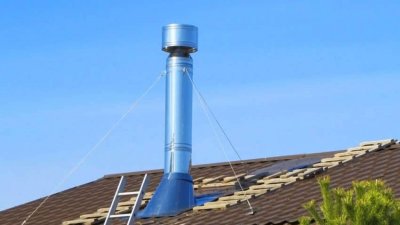
All gas boilers with an open combustion chamber operate on the principle of traction - warm air rises and is replaced by fresh air, which supports combustion.
A chimney is used to remove combustion products from the building and create draft.
Content
- Which chimney to choose
- Characteristics of chimneys for gas boilers
- Pipe height
- Design of a system for the removal of flue gases in a private house
- Coaxial types of gas exhaust devices
- How to protect yourself from blockages
- How to check the smoke exhaust structure
- Useful video
- Conclusion
- Comments (1 opinion)
Which chimney to choose
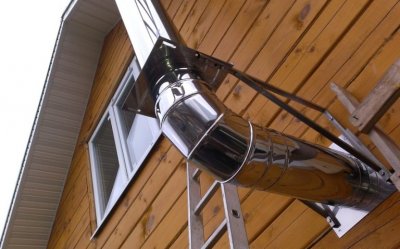
For a gas boiler, the chimney must have the following characteristics:
- Efficiency. Parameters required to ensure boiler operation.
- Safety. The structure must not overheat, and carbon monoxide leaks are unacceptable.
- Structural rigidity — the ability to withstand wind loads and its own weight.
- Matching the boiler.
- Low cost.
- Availability.
- Aesthetics.
Characteristics of chimneys for gas boilers
To ensure smooth operation of the boiler, you need to choose the right pipe. Please note the main characteristics.
Diameter
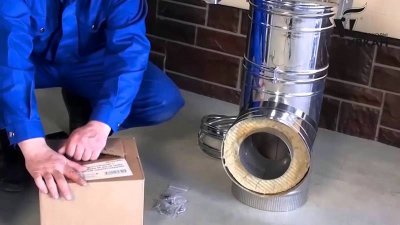
The internal cross-sectional area of the chimney is the main characteristic that directly affects the efficiency of the boiler.
When choosing, you should be guided by the principle of reasonable sufficiency; centimeters taken “in reserve” can disrupt the operation of the equipment.
Small cross-section does not cope with smoke removal and the flame periodically goes out, and combustion products can enter the room.
If the speed of gas movement in a chimney that is too wide is low, the warm air at the outlet will mix with the cold air, cool down and stop - "air lock" effect. Possible backdraft effect — when there is a strong wind or high atmospheric pressure, the draft decreases and the wind “blows” air into the pipe.
The optimal cross-section and length of the pipe is specified in the documentation for the boiler. If it is unknown which boiler will be installed, we calculate its approximate power. The more powerful the boiler, the wider the pipe should be. There are online calculators and tables of the ratio of power and width. The minimum for popular boilers in 12 kilowatts chimneys are used 110 mm.
Position in space
For a boiler with an open combustion chamber, operating on the draft principle, they design vertical chimney. The draft occurs in the pipe due to the pressure difference, the higher and wider, the greater the draft. The chimney may contain short horizontal sections for connecting a boiler or wall passage. When designing a system, it is worth remembering that turns and bends create eddies that significantly reduce draft.
Section shape
In a chimney, warm air does not move straight, but swirls. The movement of warm air is affected by the Coriolis force. With a round cross-section of the pipe, this force helps the draft - the air moves in a smooth upward spiral.
For ease of sealing the pipe into the brickwork, a oval section. The Coriolis force also works in these chimneys, as they have a rounded shape.
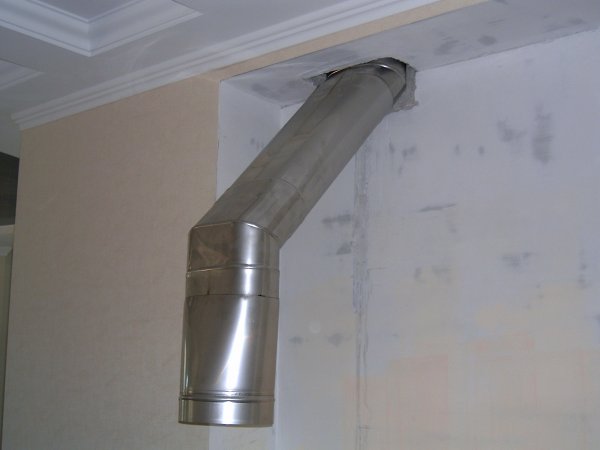
Photo 1. Oval flue for a gas boiler. This type is convenient to install in brickwork.
In brick channels without liner, the pipe cross-section square or rectangular. Square pipes are much better at removing smoke, as their shape is close to a circle. With a rectangular cross-section, the air, swirling, slows down due to the resistance of the long walls. This affects the speed of gas passage through the pipe. It is better to line such chimneys with an oval insert.
Material
Combustion products in modern gas boilers have a low temperature. Moving through the pipe, gases cool and condense. Contained in gases soot, sulfur, water vapor settle on the walls. The condensate is an active chemical oxidizer - on is capable of destroying the wall material. Based on this, smooth, durable and acid-resistant materials should be used.
In order for the draft to be uniform, the gases in the pipe should not cool down excessively. For this, the chimney must have low thermal conductivity coefficient.
Brick
Not suitable for gas boiler due to porosity and heterogeneous structure. Condensate saturates the masonry joints and comes out. When the condensate freezes and cools, the joints and bricks are destroyed.
Galvanized steel
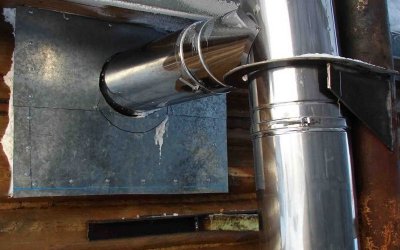
It has increased anti-corrosion properties, however, zinc in the pipe reacts with a weak solution of sulfuric acid in the condensate.
The service life of such a chimney is short - condensation will quickly eat through the protective layer, and bare iron is not able to withstand aggressive influences.
Stainless steel
Acid-resistant grades are used for chimneys. Simple food-grade stainless steel will last longer than galvanized steel, but the result will be the same. Acid-resistant grades (ALSL 304, 321, 401) steel even with a small thickness will last longer. Wall thickness for a gas boiler should not be less than 0.8 mm, since temperature changes can deform thin walls.
Cast iron

Rarely used due to the complexity of installation - cast iron pipes are thick-walled and heavy.
Cast iron copes well with caustic condensate, but it has a significant drawback - is destroyed by sudden temperature changes.
A pipe can burst in frosty weather - the temperature difference in the wall can reach 150-200 degrees!
Plastic
Not suitable for chimneys, as most plastics are thermoplastic. They become soft when heated, and can burst when the temperature changes. Use of plastics unacceptable for fire safety reasons.
Thermoset pipes with fiberglass reinforcement are also not suitable - they do not have a uniform structure, at elevated temperatures they are destroyed.
Asbestos cement pipes
Due to the porous structure, they have poor resistance to condensation., and when the temperature changes in the cold season, stress accumulates inside and the pipe can burst and fall apart. The use of these inexpensive pipes is justified only in technical rooms, where damage and smoke will not cause poisoning and costs.
Ceramics
Modern multilayer ceramic chimneys Suitable for any combustion sources. Fired glazed ceramics resist condensation, do not absorb steam, and maintain temperature. Around the ceramics, manufacturers place a fibrous "warm" material with air chambers, the thermal insulation prevents the ceramic core from overcooling and reduces internal stress.
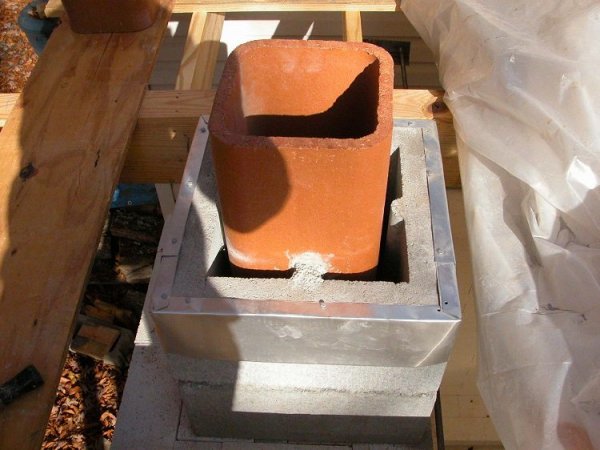
Photo 2. Installation of a square ceramic chimney. The product is protected from above by concrete foam blocks.
Ceramic chimneys easy to install, stable and durable. Minus - high cost and need for foundation.
Tightness
The chimney should not have air leaks or tight joints. The entry of cold "unaccounted" air reduces the draft, mixes cold air. At low atmospheric pressure, in calm or strong wind, combustion products may enter the house.
When using a composite pipe The upper joint of the knee should fit into the lower one. This is done so that the flowing condensate remains inside the pipe and is removed into the sewer through the drip tray.
The inner walls of the chimney must be smooth.. Roughness of the masonry, protruding fasteners or bent edges of the pipes are not allowed. Air friction on unevenness generates vibrations, and the pipe "hums" like a ghost.
Pipe height
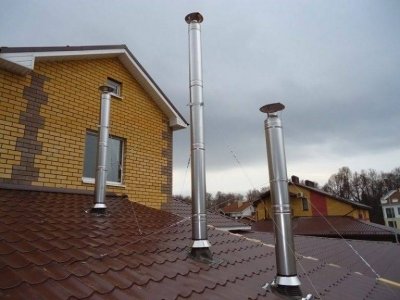
The issue of determining the height of the pipe is important from the point of view of fire safety and ensuring even draft.
The chimney must be higher than the edge of the roof, otherwise, combustion products will “smoke” the walls and gables of the building, and combustion products will not mix effectively with the air.
The ratio of the height and diameter of the pipe affects the draft. For most domestic boilers, the length of the pipe is sufficient to ensure draft. 4-6 meters.
For the boiler to function properly, It is important to maintain the ratio of the height of the pipe to the ridge.
| Distance from the ridge to the pipe. | Height relative to the ridge. |
| To 1.5 meters. | Above on 500 mm. |
| 1.5 - 3 meters. | Level with the ridge. |
| Over 3 meters. | Below the ridge on 10°. |
Solving draft problems by significantly increasing the height of the chimney is ineffective - the pipe will be subject to high wind loads. If there are draft problems, it is better increase the diameter and insulate the pipe.
Important! The height of the chimney must be increased if the head is located in the wind pressure zone.
If there is a tall building or a tree with a dense crown nearby, everything that is “in the shadow” of the building at an angle of 45°, blowing and reverse draft are possible. In this case, the height of the pipe relative to the building is raised, based on the data in the table.
Design of a system for the removal of flue gases in a private house
Classic chimney construction scheme:
- Drip. Needed for collecting and draining condensate. A sealed vessel with a drain cock at the bottom.
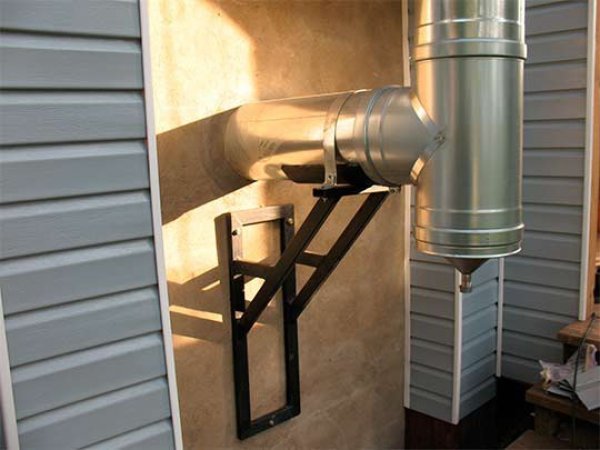
Photo 3. Part of the chimney structure with a drip cap. A special drain cock can be seen at the bottom.
- Tee for connecting the deviceIf the chimney is not attached (does not rest with all its weight on the boiler), a tee is needed to connect the boiler.
- Pipe. It can be embedded in brickwork or simply fixed to brackets.
- Passing through ceilings or walls. To comply with fire safety regulations, chimneys are insulated from wooden structures using a cutting insulated box or masonry fluff.
- Insulated area. Insulation can increase draft and reduce condensation. Non-flammable material such as basalt or kaolin mineral wool is suitable for these purposes. It is not always rational to insulate a chimney inside a building.
- Head-deflector or umbrella. Protects against rain and snow getting inside the channel; deflectors of some designs can improve draft and prevent blowing.
Coaxial types of gas exhaust devices
Gas boilers with a closed combustion chamber and forced removal of combustion products use coaxial chimneys. They have a "pipe in pipe" structure. The boiler's smoke exhauster "blows out" warm air through the inner one, and air enters the combustion chamber through the outer one. The advantage is that the temperature The outgoing gases are low and they heat the incoming oxygen. Passing through the wall is safe - the wall is separated from the hot gases by a flow of cold gases.
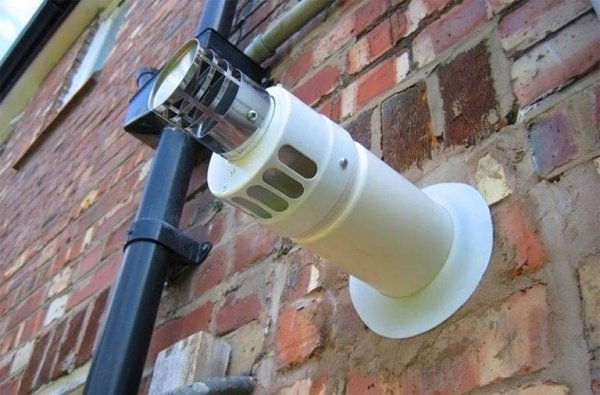
Photo 4. Coaxial chimney for a gas boiler, led outside. The product is installed horizontally.
To keep the load on the smoke exhauster to a minimum, the length of the pipe should be small and leave the premises by the shortest route - horizontally.
The coaxial principle can be used only in boilers with a closed combustion chamber and forced smoke removal. Such boilers are energy dependent and are not suitable for everyone.
How to protect yourself from blockages
Over time, a layer of smoke appears inside the chimneys of gas boilers. soot deposits and streaks of condensation mixed with dust. Periodically, to maintain the cross-section and comply with fire safety standards, the pipe must be cleaned..
Attention! Soot easily ignites and heats up the walls up to 1200 degreesThis may result in a fire or deformation of the pipe sleeve.
For effective cleaning at every turn of the chimney and at its base cleanout doors are providedCleaning is done with a wire brush and scrapers.
Cleanout doors must be hermetically sealed and not damage the cross-section of the pipe.
How to check the smoke exhaust structure
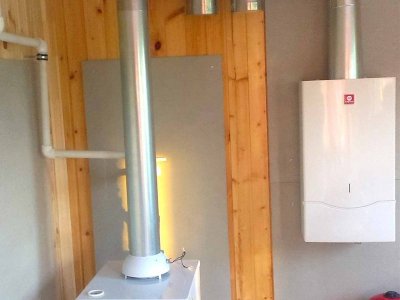
The main characteristic of a chimney is draft. It can be checked with special devices, as well as using "folk" methods:
- We light a sheet of paper and bring it to the connection tee. If the flame is completely drawn in, the smoke is removed - the draft is good.
- We cover the connection hole with a sheet of paper. The sheet should hold and not fall.
The tightness of the chimney is checked with smoke — the top is plugged, a smoke bomb is placed inside or a damp rag is burned. Smoke leaks are visible to the naked eye.
Useful video
Watch the video, which explains exactly how to connect a coaxial chimney to a gas boiler.
Conclusion
The chimney affects the smooth operation of the boiler and its efficiency.Before designing a heating system, be sure to consult with specialists and review ready-made heating examples.






Comments